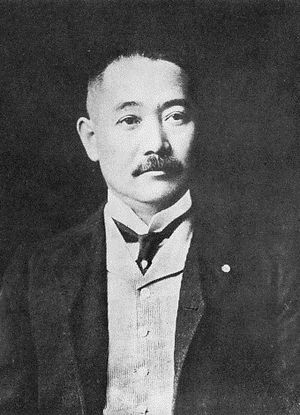Kōjirō Matsukata facts for kids
Quick facts for kids
Kōjirō Matsukata
|
|
|---|---|
 |
|
| Born | January 17, 1865 Satsuma, Kagoshima Prefecture, Japan
|
| Died | June 24, 1950 (aged 85) Osaka, Japan
|
| Education | Rutgers University |
| Occupation | Businessman, art collector |
Kōjirō Matsukata (松方 幸次郎, Matsukata Kōjirō, January 17, 1865 – June 24, 1950) was a Japanese businessman. He spent much of his life and money collecting Western art. He hoped this art would form the start of a national museum in Japan. This museum would focus on amazing Western artworks.
Even though his dream didn't fully come true while he was alive, part of it is now real. Some of his collection is shown at Japan's National Museum of Western Art (NMWA). This museum is in Ueno Park, central Tokyo.
Contents
Early Life
Kōjirō Matsukata was born in Satsuma, Kagoshima. He was the third son of Matsukata Masayoshi. His father was an important figure in the early Meiji period. He served as Japan's Finance Minister and was also the fourth prime minister.
Business Success
Matsukata studied in the United States. He went to Rutgers Preparatory School and Rutgers University. After his education, he became the president of Kawasaki Shipbuilding Company in 1896.
From 1916 to 1923, he led Kawasaki Dockyards. This was the main company of the group. He helped expand shipbuilding for both commercial and military uses. He also started other businesses, like a big shipping line called Kawasaki Kisen Kaisha (also known as K Line).
These companies grew into a large global industrial group. Today, it is known as Kawasaki Heavy Industries. Matsukata had great financial success early in the century. However, his businesses faced problems in the 1920s and 1930s. Even so, much of his art collection stayed safe.
Collecting Art
Matsukata spent a lot of his personal money on art. He bought thousands of Western paintings, sculptures, and decorative items. He collected these artworks mostly in Paris, France.
He bought the famous Rodin sculpture, "Gates of Hell." This artwork is now at the Rodin Museum in Paris. The sculptures you see at the NMWA entrance were made from the same original molds. Matsukata wanted his collections to be in a Tokyo art museum. He hoped visitors could easily see Western art there. He wanted people in Tokyo to enjoy great art, just like people in Paris.
Matsukata also collected ukiyo-e woodblock prints. These prints had been spread all over the world. An exhibition of his collected ukiyo-e in 1925 was the first of its kind in Japan. Today, about 8,000 ukiyo-e prints from his collection are at the Tokyo National Museum.
Matsukata was a good friend of the famous painter Claude Monet. It is said that Monet once let him choose any paintings he wanted from his studio. Matsukata bought 18 paintings that day. Another artist friend was Frank Brangwyn. Brangwyn helped Matsukata find artworks for his collection. Brangwyn even designed a gallery for Matsukata. It was called the "Palace of Shared Pleasure." Matsukata planned to build it in Tokyo.
Challenges for the Collection
Matsukata originally wanted to bring all his artworks to Japan. But Japan had a very high tax (100%) on imported art. So, many pieces stayed in Europe.
Sadly, much of the art stored in Britain was destroyed by fires during World War II. Also, many artworks that remained in Japan were lost due to Allied bombing. Because of these events, the Japanese public only saw a large part of his collection in 1959. This was when the museum he dreamed of finally opened.
Art Returns to Japan
Many of Matsukata's collected works were stored in French museums. This was done under the care of Léonce Bénédite, a famous French art curator. These artworks stayed in France until after World War II.
After the war, as part of the San Francisco Peace Treaty, France briefly took ownership of them. However, the French government later decided to return most of these artworks to Japan. This was a sign of renewed friendship between the two countries. But France kept 14 valuable paintings. These included works by Monet, Van Gogh, and Cézanne. They were kept to fill gaps in France's own national collection.
The remaining Matsukata collection included 370 works. These were 196 paintings, 80 drawings, 26 prints, and 63 sculptures. The sculptures included large public statues by Rodin. These statues now stand beautifully in front of the NMWA entrance. Each Rodin sculpture at the NMWA was made from the original molds. Matsukata had paid for the best Rodin castings in France. However, he couldn't bring them to Japan, which is how they ended up in French hands after the war.
These artworks, known as the Matsukata Collection, were returned by France to Japan in 1959. This led to the opening of the National Museum of Western Art.
Images for kids
-
Rodin's "The Thinker" near the entrance of the National Museum of Western Art.






